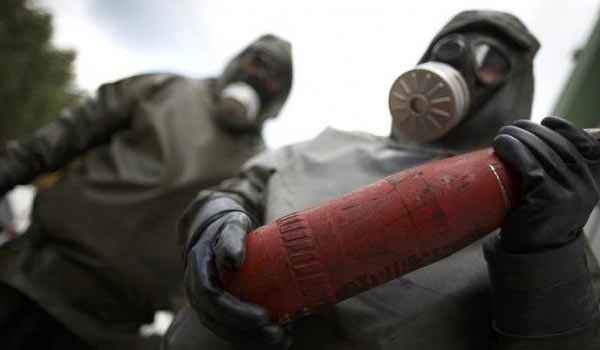
RNA - The international human rights organization published a report this week on the alleged "nerve-agent use" in Syria, which featured images of what HRW believed to be two remnants of Soviet-produced bombs, allegedly found in the town of Khan Sheikhoun in Syria’s province of Idlib, RT reported.
The fragments of what the militants claim to be a bomb loaded with chemical weapons were compared to a museum mock-up of a KhAB-250 Soviet bomb in a combination of images published by HRW.
Russia’s Defense Ministry commented on the report on Tuesday, questioning the use of a photo from a Moscow museum as a substantial proof and noting that the HRW did not conduct any investigation on the ground.
"First of all, Soviet KhAB-250 munitions have never been exported outside the USSR, and every single one of them has been disposed of back in the 1960s," the spokesman for the Russian Defense Ministry, Major General Igor Konashenkov, said in a statement on Tuesday.
HRW specifically said in its report that they had "interviewed 60 people with first-hand knowledge of the chemical attacks and their immediate aftermath, and reviewed dozens of photos and videos of impact sites and victims that were posted online and provided directly by local residents." The group stressed, however, that it was "unable to conduct ground investigations of the attack sites."
HRW used digitally-enhanced aerial image and locally sourced photos of a "crater," which it said was an impact from the sarin containing bomb, allegedly dropped from a Syrian warplane.
Konashenkov, however, said the munitions that the HRW alleges were used in Khan Sheikhoun and elsewhere did not leave craters in the first place.
"When deployed, the KhAB-250 bombs exploded midair, at the height of between 30 and 70 meters, so no crater would have been left from it," the ministry spokesman said.
Konashenkov then claimed that, in reality, the bombs in question "have never been loaded with sarin." He did not explain the inscription on the museum mock-up, which states “sarin.”
Meanwhile, the reported crater in Khan Sheikhoun had been grouted with cement by "local militants," after Damascus invited experts from the Organization for the Prohibition of Chemical Weapons (OPCW) to study the site, Konashenkov added.
"A month has passed since the incident in the Syrian Khan Sheikhoun, where chemical weapons have been allegedly deployed. However, neither the US representative, nor the UK or France who have thrown [around] 'chemical attack' accusations, have presented any concrete evidence to the public or to the OPCW," Konashenkov said in the MoD statement.
The ministry also reiterated Russia’s calls for a "special mission of experts" to come to the Syrian city and investigate the incident on the ground.
847/940